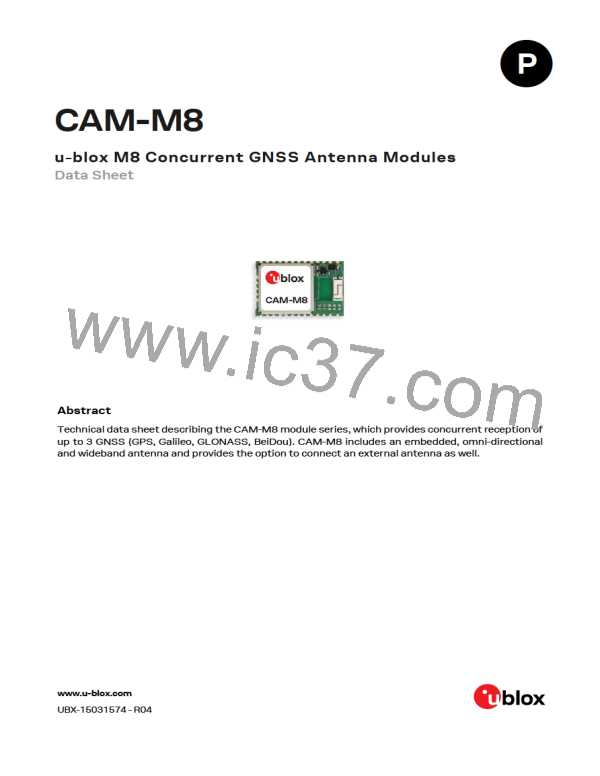CAM-M8 - Data Sheet
secret ID key set by eFuse in production and a dynamic ID key set by the host, enabling users to
detect “man-in-the-middle” style attacks.
1.12 Spoofing detection
Spoofing is a process whereby a malicious third party tries to control the reported position via a
“fake” GNSS broadcast signal. This may result in the form of reporting incorrect position, velocity or
time. To combat against this, CAM-M8 series modules include spoofing detection measures to alert
the host when signals appear to be suspicious. The receiver combines a number of checks on the
received signals looking for inconsistencies across several parameters.
☞
This feature does not guarantee to detect all spoofing attacks.
1.13 EXTINT: External interrupt
EXTINT is an external interrupt pin with fixed input voltage thresholds with respect to VCC_IO. It can
be used for Control of the receiver or for Aiding.
For more information about how to implement and configure these features, see the u-blox 8 / u-blox
M8 Receiver Description Including Protocol Specification [2] and the CAM-M8 Hardware Integration
Manual [1].
1.13.1 Pin control
The pin control feature allows overriding the automatic active/inactive cycle of Power Save Mode.
The state of the receiver can be controlled through the EXTINT pin.
The receiver can also be forced OFF using EXTINT when Power Save Mode is not active.
1.13.2 Aiding
The EXTINT pin can be used to supply time or frequency aiding data to the receiver.
For time aiding, hardware time synchronization can be achieved by connecting an accurate time
pulse to the EXTINT pin.
Frequency aiding can be implemented by connecting a periodic rectangular signal with a frequency
up to 500 kHz and arbitrary duty cycle (low/high phase duration must not be shorter than 50 ns) to
the EXTINT pin. Provide the applied frequency value to the receiver using UBX messages.
1.14 TIMEPULSE
A configurable time pulse signal is available with CAM-M8 series modules.
The TIMEPULSE output generates pulse trains synchronized with GPS or UTC time grid with
intervals configurable over a wide frequency range. Thus it may be used as a low frequency time
synchronization pulse or as a high frequency reference signal.
By default the time pulse signal is configured to 1 pulse per second. For more information, see the
u-blox 8 / u-blox M8 Receiver Description Including Protocol Specification [2].
UBX-15031574 - R04
Production Information
Page 12 of 31

 U-BLOX [ u-blox AG ]
U-BLOX [ u-blox AG ]